Sightseeing in Nepal
Sightseeing in Nepal :: Nepal Sightseeing Tour
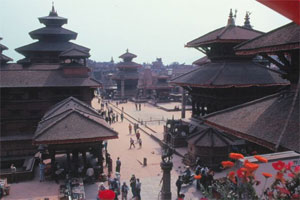 Sightseeing tour to medieval towns of Kathmandu valley and on to a beautiful city Pokhara. A gentle walk in the low- lying hills fringing the outskirts of Pokhara, designed for the first time trekker, culturally rich in the villages one passes through and an ever increasing magician the build - up of mountain views till a climax from the Poonhill on the third day of the trek and shrine to lowland Lumbini, birth place of lord Buddha and on to Chitwan National park for wildlife safaris and drive back to Kathmandu is a life experience in Nepal.
Sightseeing tour to medieval towns of Kathmandu valley and on to a beautiful city Pokhara. A gentle walk in the low- lying hills fringing the outskirts of Pokhara, designed for the first time trekker, culturally rich in the villages one passes through and an ever increasing magician the build - up of mountain views till a climax from the Poonhill on the third day of the trek and shrine to lowland Lumbini, birth place of lord Buddha and on to Chitwan National park for wildlife safaris and drive back to Kathmandu is a life experience in Nepal.
KATHMANDU:
The country's capital and largest city simultaneously reeks of history and the wear and tear of increasing modernity. Kathmandu's core is Durbar Square, with the Vishnumati River to the west and Ratna Park to the east. The Bagmati River forms the southern boundary, while Thamel, the budget travelers' hangout, sprawls to the north.
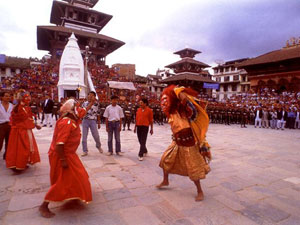 Kathmandu Durbar Square. This complex of palaces, courtyards and temples, built between the 12th and 18th centuries, used to be the seat of the ancient Malla kings of Kathmandu. An intriguing piece here is the 17th-century stone inscription set into the wall of the palace with writings in 15 languages. The Durbar Square, protected as a UNESCO World Heritage Site, is the social, religious and urban focal point of the city. There are also museums inside the palace building. There is an entrance fee of Rs. 250 for foreign visitors. Your ticket to the Square entitles you to visit all the museums.
Kathmandu Durbar Square. This complex of palaces, courtyards and temples, built between the 12th and 18th centuries, used to be the seat of the ancient Malla kings of Kathmandu. An intriguing piece here is the 17th-century stone inscription set into the wall of the palace with writings in 15 languages. The Durbar Square, protected as a UNESCO World Heritage Site, is the social, religious and urban focal point of the city. There are also museums inside the palace building. There is an entrance fee of Rs. 250 for foreign visitors. Your ticket to the Square entitles you to visit all the museums.
Walkabout. A colorful and enlightening walk that gives you a feel of Kathmandu starts at Rani Pokhari, the large pond at Jamal beside the clock tower. The first stretch of the diagonal street leading southwest from here is called Kamalachhi. It is lined with bicycle and garment stores and brings you to the stone-paved market square of Asan, where the Annapurna temple presides over a motley of spice, grain and oil shops. Keep on walking and you come to Kel Tole after passing shops overflowing with brass utensils. Further on is the junction of Indra Chowk with the temple of Akash Bhairav occupying one side. Your next stop after threading your way through the street lined with cloth shops is the stone-paved plaza of Makhan, where the Taleju temple towers over a row of handicraft shops. Walk on through Durbar Square to the intersection of Maru where you are surrounded by temples of all shapes and sizes.
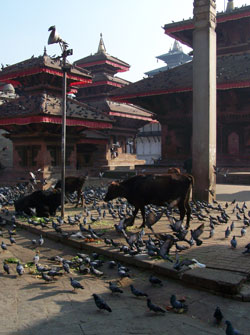 Heritage Walk. A walk through selected historic sites seldom visited. This revitalizing walk starts at Teku, south of old Kathmandu, leading on to Wonder Narayan, a 17th-century temple dedicated to Lord Bishnu. Strolling through Hyumat Tole, arrive at Kusah Bahi, a Buddhist courtyard built in 1754. The next stop is the Narayan Dewal, another Bishnu temple (built in 1865) with a small Ganesh temple at the entrance. Walk on to Tukan Baha, built in the 14th century as a replica of the Swayambhu stupa. Admire the Ram temple at the Ramchandra Dewal before reaching Jaisi Dewal, a huge Shiva temple built in 1688. Saunter down to Kohiti to study the Buddhist and Hindu sculptures in this sunken water fountain. Walk through Chikan Mugal and stop by at the Atko Narayan Dewal, an important Bishnu temple built in 1857, before visiting the namesake of the city, the Kasthamandap pavilion. After a further five-minute walk, reach the final destination, the Bhimsen Dewal, built in 1655 and dedicated to the main deity of local traders.
Heritage Walk. A walk through selected historic sites seldom visited. This revitalizing walk starts at Teku, south of old Kathmandu, leading on to Wonder Narayan, a 17th-century temple dedicated to Lord Bishnu. Strolling through Hyumat Tole, arrive at Kusah Bahi, a Buddhist courtyard built in 1754. The next stop is the Narayan Dewal, another Bishnu temple (built in 1865) with a small Ganesh temple at the entrance. Walk on to Tukan Baha, built in the 14th century as a replica of the Swayambhu stupa. Admire the Ram temple at the Ramchandra Dewal before reaching Jaisi Dewal, a huge Shiva temple built in 1688. Saunter down to Kohiti to study the Buddhist and Hindu sculptures in this sunken water fountain. Walk through Chikan Mugal and stop by at the Atko Narayan Dewal, an important Bishnu temple built in 1857, before visiting the namesake of the city, the Kasthamandap pavilion. After a further five-minute walk, reach the final destination, the Bhimsen Dewal, built in 1655 and dedicated to the main deity of local traders.
Swayambhu Stupa watches over the Valley from the top of a hillock on its western side. The stupa is one of the holiest Buddhist sites in Nepal and its establishment is linked to the creation of the Kathmandu Valley out of a primordial lake. Swayambhu is also known as Samhengu and is listed as a World Heritage Site. Entrance fee Rs. 50 (SAARC nationals Rs. 30).
Balaju consists of a sprawling garden of stone water spouts, religious shrines, fish ponds, and a replica of the statue of Budhanilkantha. Situated below Nagarjun hill about 3 km northwest of the city center, Balaju is known for its bank of 22 stone water spouts (hiti) carved in the shape of sea-dragons. Devotees take ritual baths under the gush of water. Balaju is also known as Lhuti.
Budhanilkantha is situated below Shivapuri hill at the northern end of the Valley. It is about 9 km from the city center. The hub of the temple complex is a pond in which lies a great stone figure of the Hindu god Bishnu reclining on the coils of a cosmic serpent. It is also known as Bhuijasi.
Bouddhanath Stupa lies about 6 km to the east of downtown Kathmandu and is the largest stupa in the Valley. It looms 36 meters high and presents one of the most fascinating specimens of stupa design.
Bouddhanath, a World Heritage Site, is also known as Khasti. There are more than 45 Buddhist monasteries in the area. Many have schools that teach young monks like thoughs pictured here.
An information counter, run by the Bouddha Area Preservation & Development Committee (Ph: 471368), offers assistance to visitors.
Pashupatinath Temple. One of the most sacred Hindu shrines in the world, Pashupatinath lies 5 km east of the city center. The richly-ornamented pagoda houses the sacred linga, or phallic symbol, of Lord Shiva.
Religious pilgrims and sahdus, like the one pictured here, travel all the way from the remote areas of India to visit this sacred sight. Even though these devotees have denounced worldly possessions, each carries a Sahdu ID (identifications card) to freely cross over the border between India and Nepal.
Chronicles indicate the Pashupatinath’s existence prior to 400 AD. Devotees can be seen taking ritual dips in the holy Bagmati river flowing beside the temple, also a World Heritage Site.
Kirtipur (pop. 35,000) is situated on a ridge 6 km southwest of Kathmandu. The ancient township is a natural fortress and has a proud and courageous history. The Chilamchu stupa and the temple of Bagh Bhairav are major sights here. Kirtipur offers quaint streets lined with artistic houses and temple squares. The people are known for their skill in building and weaving.
Dakshinkali and Chobhar. The temple of Dakshinkali is dedicated to the Hindu goddess Kali and is one of the most popular places of worship in Kathmandu. Located 22 km from the city center on the southern rim of the Valley past Pharping village, the shrine is especially crowded on Tuesdays and Saturdays when animal sacrifices are offered to the deity. On the way back, stop at Chobhar gorge. The narrow gash in the hills was made by Lord Manjushree to drain out the lake which once covered the Valley.
PATAN:
Patan, the second-largest city in the valley, lies just across the Bagmati River from Kathmandu, but it's a much quieter and less frenetic place to visit. The city is justly proud of its temples and artisans and it is their handiwork that provides the focus of the stunning Durbar Square - choc-a-block with the largest display of Newari architecture in Nepal. It includes the Royal Palace, which contains a richly decorated bathtub, and the two-tiered brick Jagannarayan Temple. A few minutes' walk north of the square is the Golden Temple, a Buddhist monastery guarded by sacred tortoises that potter around the courtyard; and the Kumbeshawar, reputedly the oldest (1392) temple in Patan. South of the square is an area of charming streets lined with metal smiths and brassware shops.
Patan's other attractions are flung further field. Tibetan carpets can be bought in Jawlakhel, east of the city.
Patan Durbar Square, like its counterpart in Kathmandu, is an enchanting melange of palace buildings, artistic courtyards and graceful pagoda temples. Listed as a World Heritage Site, the former royal palace complex is the center of Patan’s religious and social life, and houses a museum containing an array of bronze statues and religious objects. There is an entrance fee of Rs. 200 per foreign visitor. One remarkable monument here is a 17th-century temple dedicated to the Hindu god Krishna, built entirely of stone.
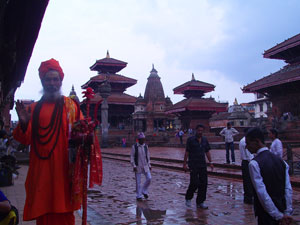 Iba Bahi is situated about a two-minute walk south of Durbar Square. It is one of the oldest Buddhist monasteries in the Kathmandu Valley and reflects the sophisticated architecture of the Malla period. A two-step platform leads to the courtyard with a hall called Dalan. There is a shrine dedicated to Shakyamuni right across the entrance.
Iba Bahi is situated about a two-minute walk south of Durbar Square. It is one of the oldest Buddhist monasteries in the Kathmandu Valley and reflects the sophisticated architecture of the Malla period. A two-step platform leads to the courtyard with a hall called Dalan. There is a shrine dedicated to Shakyamuni right across the entrance.
Kwa Bahal, also known as the Golden Temple, is a Buddhist monastery courtyard dating to the 12th century. It is a five-minute walk west and north from the northern end of Durbar Square. The monastery building is embellished with exceptionally fine wood-carvings and repousse work. Artistic images are scattered around the courtyard, and devotees can be seen offering worship at the many shrines here. Entrance fee Rs. 25.
Mahabouddha can be reached by walking east from the southern end of Durbar Square and then turning right at the sunken water taps. This Buddhist monument is an excellent example of terra cotta artform which points to the skill of Patan’s ancient craftsmen with a variety of building styles. The 14th-century monument’s obelisk-like design is also unusual in a city of pagoda roofs.
Oku Bahal is situated a few steps past Mahabouddha and is one of the best known Buddhist places of worship in Patan. The stone-paved courtyard is enclosed by a two-story building with gilded roofs. The wood-carvings on the roof struts are especially attractive. The place is peppered with sacred images and other small shrines.
Walkabout. Besides these much frequented tourist attractions, there are other ancient parts of Patan worth sight-seeing. Nakabahi, Nyakha Chuka, Nagbaha, Swotha Square, Tumbaha, Walkhu Tole, Chyasa, Kapinche, Chapat, Subaha, Bhinchhebaha, Dupat and Nugah make up a nice half-day walk around the squares, temples and monuments of inner Patan.
The Central Zoo in Jawalakhel is a pleasant diversion after a tour of the cultural sights. It contains about 106 species of birds and over 665 different animals. There is also a pond where you can go boating. Open daily except Mondays from 10 am to 5 pm. Entrance for foreign visitors costs Rs. 60 (Rs. 25 for children under 10). Elephant ride costs Rs. 100 (Tel: 528324).
Tibetan Refugee Camp was set up in 1960 under the initiative of the International Red Cross and the Swiss Development Corporation (SDC), then known as Swiss Association for Technical Assistance (SATA), in cooperation with His Majesty’s Government of Nepal. Its main objective is to help the Tibetan refugees to do something productive and support themselves.
BHAKTAPUR:
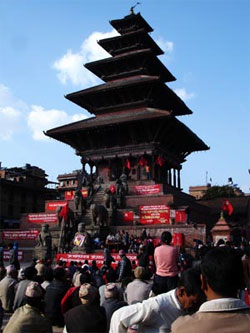 Most sights can be easily traversed by foot and include yet another Durbar Square, which is infinitely larger than Kathmandu's and has its fair share of temples, statues and columns, many with grisly histories behind them. For instance, the sculptor of the Ugrachandi & Bhairab Statues had his hands chopped off to prevent him from duplicating his masterpieces.
Most sights can be easily traversed by foot and include yet another Durbar Square, which is infinitely larger than Kathmandu's and has its fair share of temples, statues and columns, many with grisly histories behind them. For instance, the sculptor of the Ugrachandi & Bhairab Statues had his hands chopped off to prevent him from duplicating his masterpieces.
Bhakatapur's second main square is Taumadhi Tole, which features Nyatapola, the highest temple in the valley, and Til Mahadev Narayan, an important place of pilgrimage. Nearby is Potters' Square, where thousands of clay pots are made and sold. East from here, through the sinuous streets of the old city center, is Tachupal Tole, another square containing temples and monasteries plus craft museums.
Sometimes it's best to take a break from temples and sit back and watch the unchanging rituals of daily life: the laying out of grain to dry in the sun, families collecting water or washing under communal taps, children playing simple games, dyed yarns flapping in the breeze or potters at work throwing clay.
Bhaktapur is about 35km (22mi) south east of Kathmandu's city center and is easily reached by bus, minibus or trolley bus.
Bhaktapur Durbar Square. As you walk in, you cannot but be overcome by a feeling of inner harmony. Such is the art and architecture and the spacial layout here. The 15th-century Palace of 55 Windows, situated to the left as you enter through the city gate, inspires admiration. The National Art Gallery is also housed inside. The palace entrance, the Golden Gate, is a masterpiece in repousse art. In front of the palace building is a medley of temples of various designs. There is an entrance fee of Rs. 30 for SAARC nationals and Rs. 500 for other foreign visitors.
Taumadhi Square lies to the east of Durbar Square reached by a narrow brick-paved lane. The towering five-roofed Nyatapol temple presides over the square. The monument gracefully soars into the sky atop a five-story plinth. The stairway leading up to the temple is flanked by stone figures of deities and mythical beasts, each 10 times more powerful than the one immediately below.
Dattatreya Square takes its name from the Dattatreya temple dedicated to a three-headed combination of the Hindu deities Brahma, Bishnu and Shiva. If you want to experience the feel of the traditional urban layout of Bhaktapur, Dattatreya Square is it. Set in a maze of streets lined with richly ornamented houses, the square is famed for its many ornate Hindu monasteries known as Math. The National Woodworking Museum is also housed here and the Brass and Bronze Museum is across the street.
Potter’s Square. A two-minute walk south of Durbar Square brings you to Bolachhen, also known as Potter’s Square because of the many potters seen here moulding wet clay into different kinds of earthen ware. It has a display of fresh pottery left out to dry in the open square. This place can be approached from Taumadhi Square also. The elephant-headed Lord Ganesh is the patron of potters, thus the Jeth Ganesh temple in the square.
Siddha Pukhu, a pond dating back to the Lichhavi period, is better known as Ta-Pukhu, meaning big pond. Though situated right at the bus stop, it provides a serene atmosphere with its sashaying fish and the stone images of different Hindu and Buddhist gods.
Surya Binayak is one of Kathmandu’s most popular pilgrimage spots. Situated in a thick forest to the south of Bhaktapur, it is a 20-minute walk from the trolley bus terminal. The temple, dedicated to the Hindu deity Ganesh, is crowded with devotees especially on Tuesdays and Saturdays.
Changu Narayan Temple is situated on a ridge overlooking the Valley, about 12 km to the east of the city. It is dedicated to the Hindu god Bishnu. One of the finest and oldest specimens of pagoda architecture, the temple is embellished with exquisite wood and stone carvings. The sacred complex is a World Heritage Site.
OUT OF KATHMANDU VALLEY
Apart from Kathmandu, Patan and Bhaktapur, there are a number of other fascinating villages, temples and stupas scattered around the valley. One of these is probably the best known site in Nepal - the Buddhist temple of Swayambhunath. The temple is colloquially known as the 'monkey temple', after the large tribe of garrulous monkeys which guard the hill, amusing visitors and devotees with their tricks, including sliding gracefully down the long double banisters of the main stairway. The soaring central stupa is topped by an aureate block featuring the watchful eyes of Buddha. Set around the base is a continuous series of prayer wheels which pilgrims, circumambulating the stupa, spin as they pass by.
Beyond Swayambhunath, on the banks of the Bagmati River, is Pashupatinath, the country's pre-eminent Hindu temple and one of the most significant Shiva temples on the subcontinent. Surrounding Bodhnath are a number of monasteries, but be discreet and respectful if you intend visiting them.
The valley also offers plenty of opportunities to get off the beaten track, with treks to and from the resort villages of Nagarkot and Dhulikhel, wallowing in Tatopani's hot springs, exploring cloud forests in Pulchowki, Chapagaon, Bungamati, Dakshinkali the most famous Temple in the south of Kathmandu valley.



